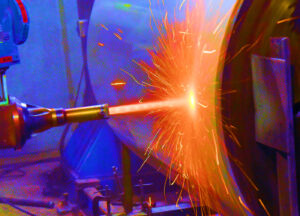High-velocity oxyfuel (HVOF) spraying is an advanced thermal spray coating process renowned for its effectiveness in enhancing the durability and performance of various materials.
In this technique, a high-velocity stream of combustion gases, typically a mixture of compressed air and fuel (propane, propylene, propane-butane, or natural gas), is directed onto a substrate. The combustion occurs in a specially designed chamber, ensuring a controlled and efficient process.
One of the distinctive features of HVOF spraying is its ability to achieve a relatively lower flame temperature compared to traditional methods.
This controlled combustion, along with the axial injection of feedstock, allows for the gentle and precise heating of powder particles. The result is a coating with exceptional properties, including high density, hardness, and carbide retention, coupled with excellent ductility.

The nozzle used in HVOF spraying has a large diameter to accommodate the volume of gases involved and to accelerate the material to speeds ranging from 600 to over 1,000 meters per second. This high-speed impact ensures a dense and tightly bonded coating.
Overall, HVOF spraying stands as a cutting-edge technology, offering superior wear resistance and extended service life for coated components in various industrial applications.
Key characteristics of the HVOF process distinguish it as a superior coating method. Notably, it operates at a lower propane flame temperature when using air (HVAF) compared to pure oxygen (HVOF).
While oxygen reaches temperatures around 2820 ºC, air maintains a lower temperature of approximately 1970 ºC. This controlled temperature environment results in less oxidation, ensuring the coating's quality.
Furthermore, the HVOF process achieves higher particle velocities, contributing to coatings with lower porosity and high bond strength.
The coatings produced through HVOF spraying exhibit remarkable hardness and wear resistance, making them ideal for applications where durability is crucial.
In conclusion, High-Velocity Oxyfuel (HVOF) coatings stand out as a revolutionary solution for enhancing the durability and performance of various materials across industries.
The controlled combustion process, lower flame temperature, and high-velocity impact contribute to coatings with superior properties such as high density, hardness, and carbide retention.
These advantages make HVOF a go-to technology for critical applications in aerospace, oil and gas, automotive, and manufacturing.
Enterprises seeking top-tier thermal spray coating services need look no further than Endurance Wear Solutions (EWS). With over 30 years of combined expertise in the field, EWS has become a trusted brand in the Indian wear solutions space.
Established in 2017, the company has been at the forefront of thermal spray coating services, spearheading innovative solutions with a focus on combating industrial wear and tear issues.
EWS specializes in US-made HVAF and HVOF coatings, offering groundbreaking solutions for challenges such as adhesion, abrasion, cavitation, corrosion, oxidation, surface fatigue, fretting, and erosion wear.
Their commitment to quality is evident in the use of superior materials like tungsten carbide with HVOF and fine, smooth-as-sprayed coatings with sub-micron carbide powder with HVAF
These coatings continue to set industry benchmarks, contributing to increased business profitability and prolonged equipment and machine component service life.
As dynamic trendsetters in the cost of ownership, EWS remains dedicated to providing customized coating services that meet the diverse needs of industries.
For those looking to optimize their equipment's performance and longevity, Endurance Wear Solutions stands as a reliable partner, ready to address wear and tear challenges through cutting-edge thermal spray coating processes.
For those looking to optimize their equipment's performance and longevity, Endurance Wear Solutions stands as a reliable partner, ready to address wear and tear challenges through cutting-edge thermal spray coating processes.
Reach out to EWS now to explore how their expertise can benefit your industry.